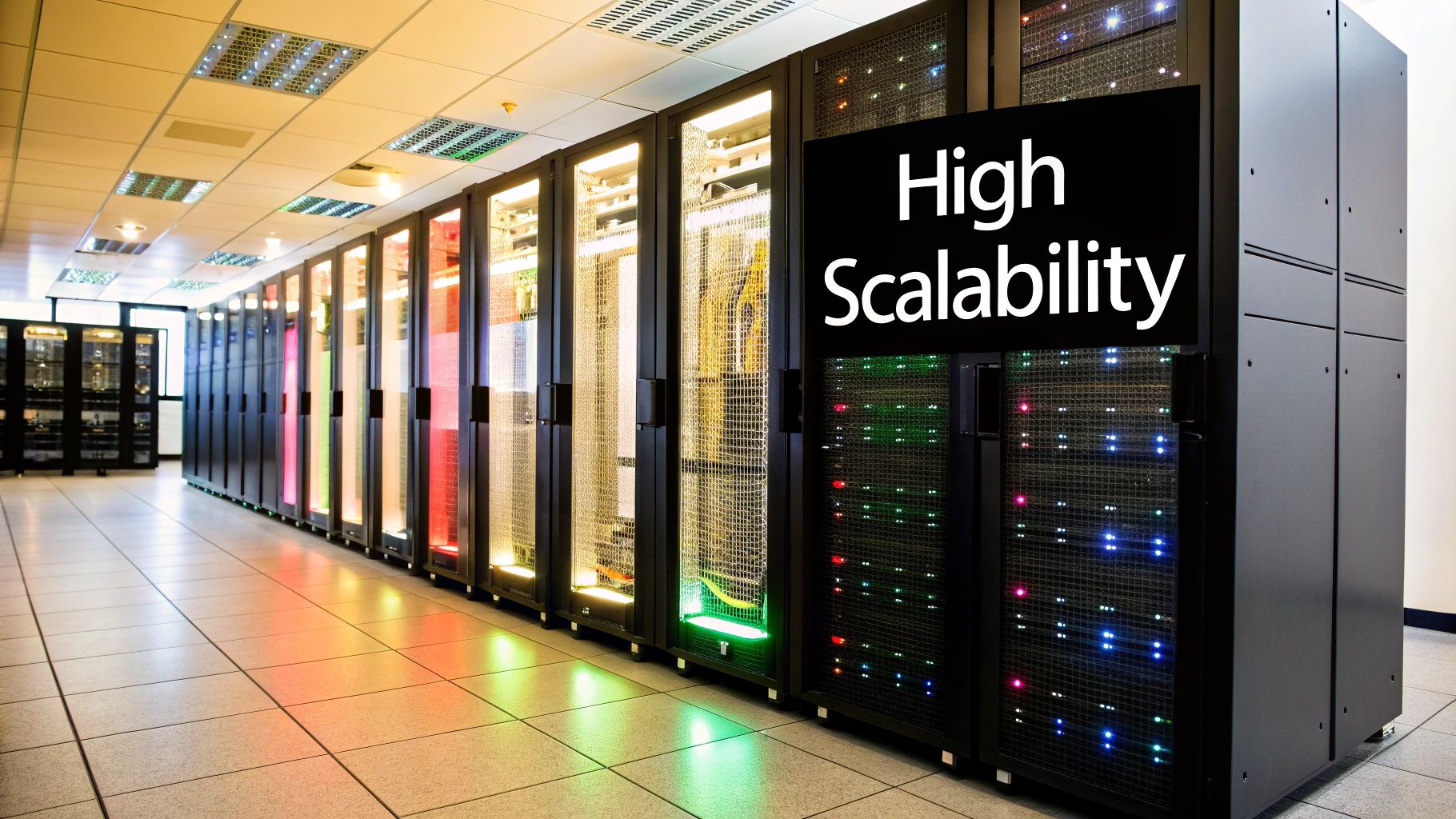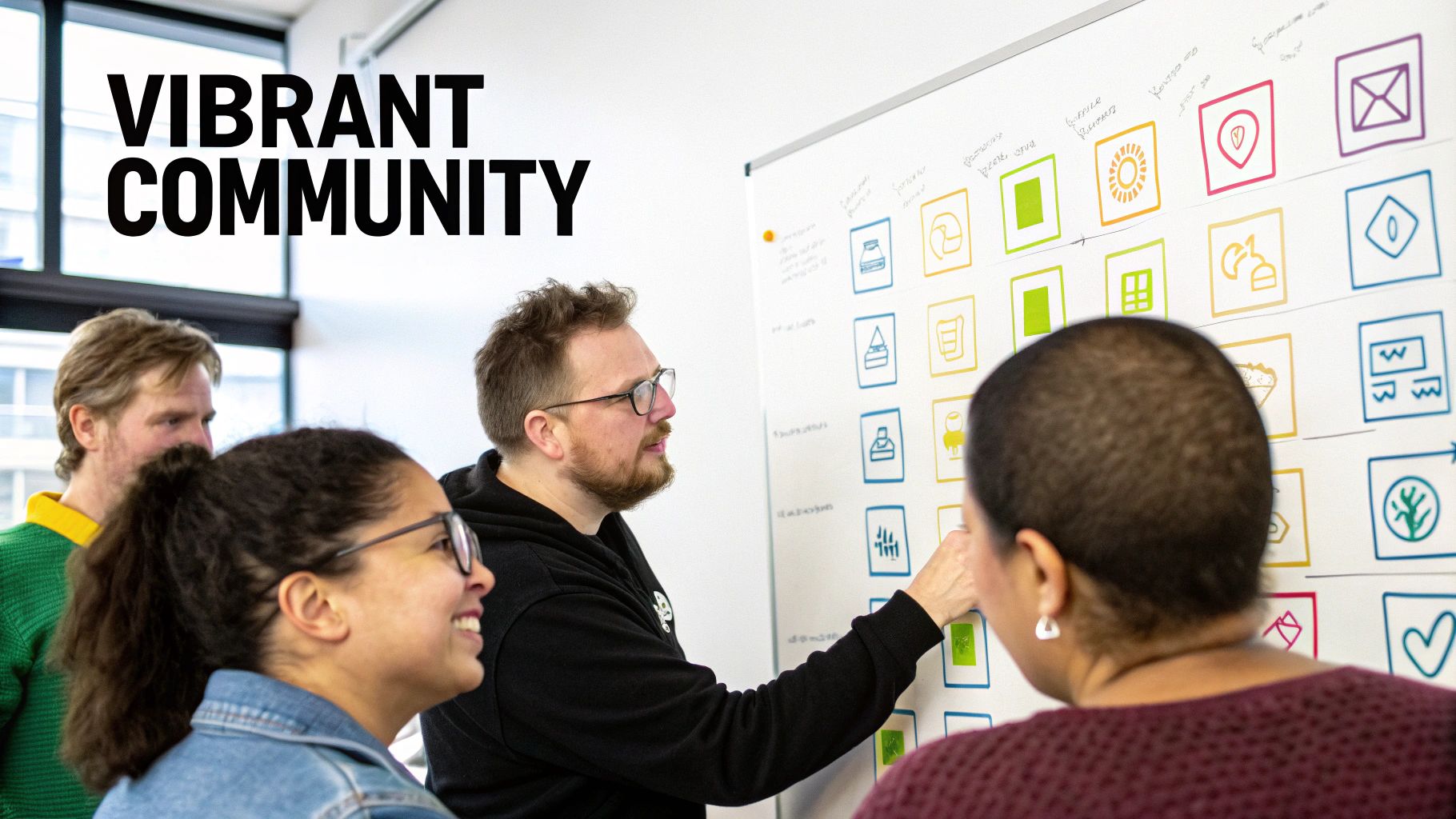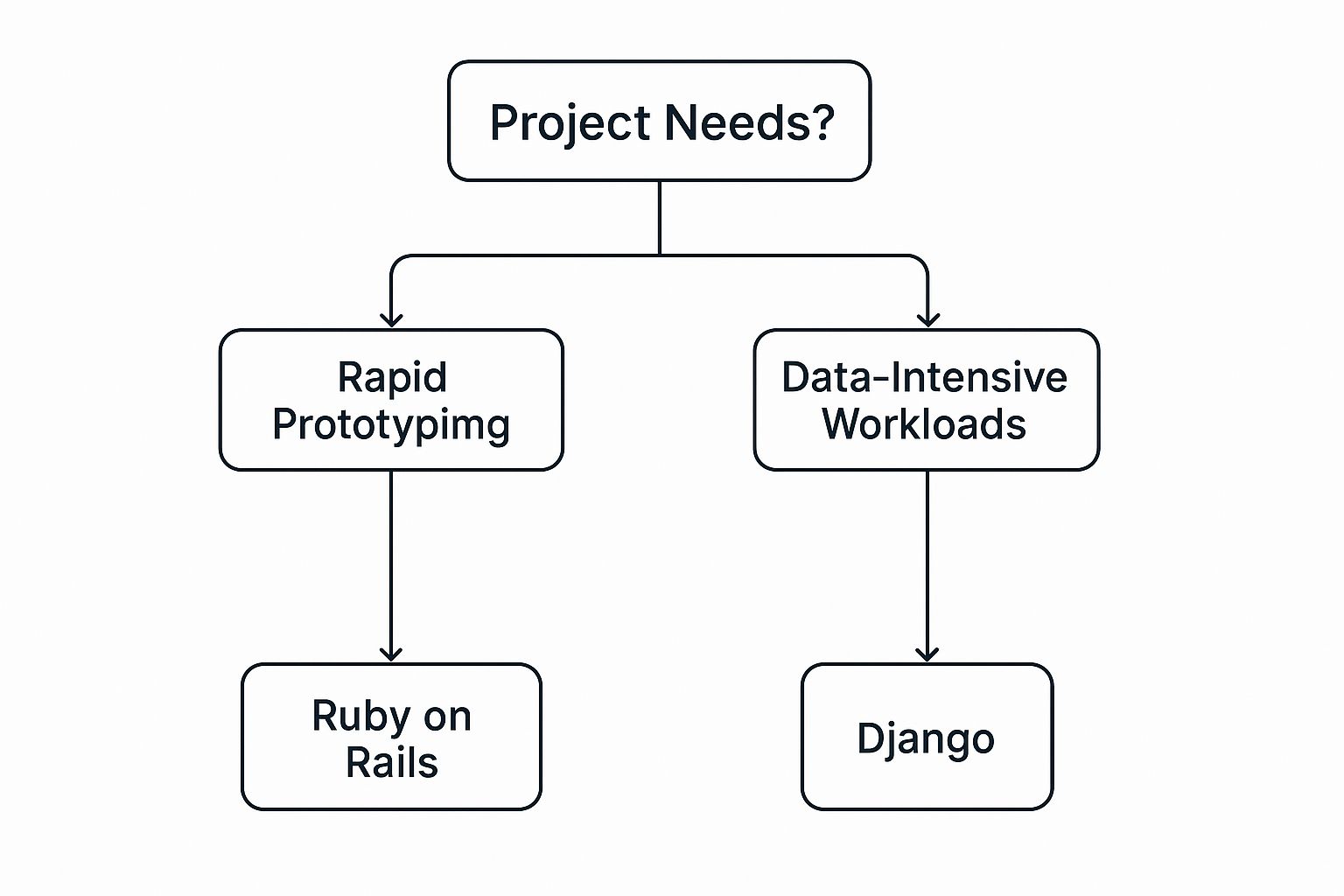Ruby on Rails vs Django The Ultimate Framework Showdown
Choosing between Ruby on Rails vs Django? This guide provides a detailed, practical comparison to help you select the best framework for your project.

When you're comparing Ruby on Rails vs. Django, the core difference really boils down to philosophy. Rails is all about 'Convention over Configuration', which means it’s designed to get you building fast. Django, on the other hand, lives by the mantra 'Explicit is better than implicit', focusing on clarity and control. The right choice for you hinges on whether you value development speed or transparent, granular control over your application's architecture.
Rails vs Django: A Quick And Practical Overview
Choosing between Ruby on Rails and Django is a classic fork in the road for developers and product owners alike. Both are powerhouse open-source frameworks for building solid web applications, but their core principles create very different development experiences. Getting a feel for these differences is the first step in picking the right tool for your project.
At their heart, both frameworks exist to tame the chaos of web development. If you need a refresher, our guide on what a web development framework is and why it's so important is a great place to start. In short, they give you a ready-made structure for handling everyday tasks like talking to databases, routing URLs, and managing security, freeing you up to focus on the features that make your app unique.
Foundational Philosophies and Languages
Ruby on Rails, built with the elegant Ruby language, is famous for its "Convention over Configuration" approach. What does that mean in practice? The framework makes a lot of smart assumptions for you, cutting down on the boilerplate code and decisions you have to make. This is why Rails is so often praised for how quickly you can get a prototype or MVP off the ground.
Django is built with Python, a language known for being incredibly readable and straightforward. Its guiding principle, "Explicit is better than implicit," means that everything is out in the open. There's less "magic" happening behind the scenes, which can make the codebase easier to understand, debug, and maintain, especially as an application grows larger and more complex.
The choice often comes down to your team’s personality. Do you prefer a framework that intuits your needs to help you move faster, or one that demands clear instructions at every turn for total clarity and control?
Both frameworks have been around the block and power some of the biggest names on the web. Ruby on Rails, which launched back in 2004, is the engine behind giants like GitHub, Shopify, and Airbnb. Django, which followed in 2005, is the foundation for Instagram, Spotify, and Pinterest. In fact, by 2025, Rails was already powering over 577,000 websites, a clear sign of its lasting influence.
To kick things off, let’s get a quick, high-level look at how they stack up before we dive deeper.
At-a-Glance Framework Comparison
This table gives you a quick snapshot of the fundamental differences between Ruby on Rails and Django. Think of it as a cheat sheet to reference as we explore the nuances of each framework.
| Attribute | Ruby on Rails | Django |
|---|---|---|
| Core Language | Ruby | Python |
| Guiding Principle | Convention over Configuration (CoC) | Explicit is Better than Implicit |
| Development Speed | Extremely fast for prototyping & MVPs | Very fast, but often requires more setup |
| Learning Curve | Steeper due to Ruby and "magic" | Gentler, especially for Python developers |
| Flexibility | Highly flexible, multiple ways to solve problems | More structured and opinionated |
Now that we have the lay of the land, let's get into the specifics of what makes each framework tick.
Comparing Development Speed And Philosophy
Picking between Ruby on Rails and Django isn't just about choosing a tool; it's about buying into a development philosophy. This choice shapes everything that follows—how quickly you can build, how you structure your code, and how easy it is to maintain your project down the road. Getting this right from the start is crucial.

Both frameworks are designed with productivity in mind and offer excellent strategies to boost developer productivity, but they get there through two completely different paths.
Ruby on Rails and The Art of Convention
At its core, Ruby on Rails champions the idea of Convention over Configuration (CoC). In simple terms, Rails makes a lot of smart assumptions for you. It's designed to get you from zero to a working app as fast as possible by cutting out repetitive decisions and boilerplate code.
Think about setting up a basic feature, like user profiles. With a single command—rails generate scaffold User name:string email:string—Rails builds everything for you. You get the database model, a full set of controller actions (for creating, reading, updating, and deleting), and all the necessary views. This feels almost like magic, and it’s why developers can prototype ideas with incredible speed.
Key Takeaway: The "magic" of Rails is its greatest strength for rapid development. It anticipates your needs, letting you focus on unique features rather than boilerplate code.
This makes Rails a fantastic choice for startups and teams focused on building Minimum Viable Products (MVPs). The framework handles the boring stuff so you can focus on building what matters. The flip side? When you need to break from those conventions, it can sometimes feel like you're fighting the framework's magic to get things done.
Django and The Power of Explicitness
Django takes the opposite approach, guided by a core tenet of Python: "Explicit is better than implicit." There's no magic here. Django wants you to be deliberate and clear about how every piece of your application connects and works.
For example, where Rails might automatically link a model to a controller based on naming conventions, Django makes you explicitly import modules and wire them together yourself. If a piece of code is running, you can follow a clear, logical path through the files to see exactly why.
This transparency pays off in several big ways:
- Clarity and Readability: New developers can jump into a Django project and understand the codebase more easily because everything is spelled out.
- Predictability: Debugging is often much simpler. You can trace data flow and logic without having to guess what the framework is doing behind the scenes.
- Granular Control: You have complete control over every component, which is a huge advantage for complex applications with non-standard requirements.
Getting started with Django might feel a bit slower than Rails because it requires more upfront setup. But for large, long-term projects, that initial investment in clarity can save you from a world of technical debt. This philosophical split—speed vs. transparency—is often the real deciding factor when choosing between the two.
Performance And Scalability Under The Hood
When developers debate frameworks, raw speed benchmarks often steal the show. But that's just a starting point. The real challenge isn't a simple speed test; it's how your application holds up when it starts to grow. True performance is about handling traffic surges, managing growth gracefully, and scaling without a complete re-architecture. This is where the core philosophies of Ruby on Rails and Django really start to diverge.

Let's look past the surface-level numbers and dig into how each framework is actually built to perform and scale when things get serious.
Ruby on Rails: Handling Growth And Demand
Rails often gets a bad rap for being "slower" out of the box. Frankly, this perception is a bit dated and misses the point. The framework is heavily optimized for developer happiness and speed of creation, which can sometimes mean a slight trade-off in initial request/response times. But that absolutely does not mean it can't handle immense traffic.
The trick to scaling a Rails app is knowing where the potential bottlenecks live. Historically, Ruby's concurrency model presented challenges, but modern Rails has evolved significantly. Today's applications lean on powerful multi-process and multi-threaded servers like Puma to manage high concurrency effectively.
At scale, the conversation shifts from raw language speed to smart architecture. It's all about your caching strategy, database optimization, and background job processing. Just look at giants like GitHub and Shopify—they prove that with the right engineering, Rails can handle massive enterprise-level traffic.
To get there, the Rails ecosystem gives you some fantastic tools right out of the box:
- Active Job: This is your secret weapon for a responsive user experience. It lets you offload heavy tasks like sending emails or processing images to a background queue, so your user isn't stuck waiting.
- Built-in Caching: Rails comes with a surprisingly sophisticated set of caching tools. You can cache anything from small parts of a view (fragment caching) to complex query results, slashing your database load.
- Connection Pooling: ActiveRecord, the Rails ORM, is smart about managing database connections. It prevents your database from getting overwhelmed during a sudden traffic spike.
Optimizing your underlying infrastructure is just as important. For a deeper look at improving system speed, check out these proven tips for faster systems and reducing latency.
Django: Built For High-Traffic Scenarios
Django's story begins in a fast-paced newsroom, and that DNA is baked right into its architecture. It was designed from day one to wrangle large datasets and handle the unpredictable traffic of a media site. This makes it an incredibly strong contender for data-heavy applications or any platform expecting huge growth.
Django’s approach to scalability is built on a few key pillars:
- Share-Nothing Architecture: This is a huge win for large systems. Django's components are decoupled, which means you can scale your database, application server, and caching layer independently as needed.
- Robust Caching Framework: Django offers a flexible caching system that can plug into popular backends like Memcached or Redis. You get fine-grained control, allowing you to cache everything from an entire page to a single, expensive database query.
- Mature ORM: The Django ORM is a powerhouse for complex database interactions. It gives developers tools like
select_relatedandprefetch_relatedspecifically to fight common performance killers like the dreaded N+1 query problem.
Ultimately, the performance debate between Ruby on Rails vs Django is nuanced. Both frameworks are more than capable of scaling to support millions of users. Rails provides the tools to help a rapidly built application grow, while Django offers a rock-solid, scalable foundation from the very beginning.
Ecosystem, Community, And Learning Curve
A framework is only as good as the community behind it. When you’re weighing Ruby on Rails vs. Django, you’re not just choosing a technology—you're choosing an ecosystem. This decision impacts everything from the libraries you can use to how quickly you can find answers when you hit a roadblock. Fortunately, both frameworks are backed by mature, passionate communities that have spent years building incredible tools.

This support system is what makes rapid development possible, letting you pull in complex features without starting from scratch. Let’s dig into how their ecosystems, communities, and learning curves really stack up.
Ruby Gems vs. Python Packages
Ruby on Rails lives and breathes through RubyGems, its package manager. It's a treasure trove of plugins, or "gems," that handle almost any function you can imagine, from user authentication with Devise to payment gateways with Stripe. The Rails community is known for creating high-quality, well-documented gems that snap right into the framework’s conventions, making them feel like a natural extension of Rails itself.
Django, on the other hand, taps into the Python Package Index (PyPI), a massive repository with hundreds of thousands of packages. Since Python’s reach extends far beyond web development into data science, AI, and scripting, PyPI is incredibly diverse. This gives Django a serious edge if your application needs to crunch numbers or integrate machine learning, with powerhouse libraries like NumPy, pandas, and scikit-learn just a command away.
The real difference comes down to focus. The RubyGems world is almost entirely dedicated to web development, which makes for a highly curated and consistent developer experience. PyPI’s sheer breadth gives Django access to a much wider array of tools, especially if your project is data-heavy.
Market share stats paint a clear picture of these strengths. Ruby on Rails maintains a solid 21.94% market share among backend frameworks, a testament to its dedicated following. Meanwhile, Django rides the wave of Python’s explosive growth in AI and data science, which constantly expands its talent pool and library options.
Community Support And Documentation
You won’t be alone with either framework. Both have incredibly active communities on platforms like Stack Overflow, Reddit, and dedicated forums. For years, Rails has been praised for its official documentation and guides—they're often held up as the gold standard for how to teach a framework. The community is tight-knit, with a deep-seated focus on web development best practices.
Because of Python's versatility, Django's community is naturally larger and more varied. This means you can find help not just for web-specific problems but also for tricky data analysis or machine learning integrations. While Django's official docs are excellent, the documentation for third-party packages can sometimes be a mixed bag compared to the consistently high quality of popular Ruby gems.
Analyzing The Learning Curve
If you're starting from square one, this is a huge deal. Django is generally seen as the easier framework to pick up, and that’s almost entirely because of Python. The language is famous for its clean, straightforward syntax. If you already know some Python, learning Django feels like a natural next step. For those looking to build on that foundation, checking out professional Python Django development services can be a great way to see how the pros do it.
Ruby on Rails can be a bit more of a climb at first. You have to learn the Ruby language and get used to the "Rails magic." This "magic" is the framework’s "convention over configuration" philosophy in action, and it's a double-edged sword for beginners. For seasoned developers, it makes development fly. For newcomers, it can hide what's actually happening behind the scenes, making debugging a real head-scratcher.
How to Choose the Right Framework for Your Project
So, how do you actually make the final call in the Ruby on Rails vs Django debate? It comes down to moving past the technical details and looking at what your project really needs. The best framework isn't just the one with the most buzz; it's the one that fits your goals, your team's skills, and where you want to go in the long run.
This is where the rubber meets the road. Let’s translate all that comparison into a practical decision.
To make things even clearer, this decision tree lays out which framework is the better fit for different project priorities.

As you can see, there's a pretty clear split. If you need to build something fast, Ruby on Rails is your friend. If your project is all about data or you've already got a team of Python developers, Django is the obvious choice.
Scenario 1: Building an MVP Quickly
When getting your product to market as fast as possible is the name of the game, Ruby on Rails often comes out on top. Its whole "Convention over Configuration" philosophy is built for speed.
You can get core features like user sign-ups, content management, or basic e-commerce functionality up and running in a shockingly short amount of time thanks to its scaffolding tools and vast library of gems. For a startup, this means you can test your idea and get real user feedback without sinking a ton of time and money into development.
When you're building a Minimum Viable Product (MVP), every hour counts. Rails is designed for developer velocity, making it an incredible tool for proving a concept on a tight schedule.
Scenario 2: Launching a Content-Heavy Platform
If you're building a news site, a big blog, or anything where managing content is the main event, Django has a serious edge. The reason is simple: its built-in admin panel is a powerhouse right out of the box.
This single feature can save you dozens, if not hundreds, of development hours that you'd otherwise spend creating a custom backend for your writers and editors. Django's explicit and structured approach also helps ensure the application stays organized and easy to maintain as your content library explodes.
Scenario 3: Developing a Scalable E-commerce Site
This is where things get a bit more interesting, because both frameworks are proven players. Shopify was built with Rails, and Django is used in plenty of complex retail systems. The right choice here really depends on the specifics of your store.
- Go with Ruby on Rails if: You want a highly customized, unique shopping experience for your users. The flexibility of Rails and its ecosystem of e-commerce gems (like Spree and Solidus) are perfect for building a storefront that stands out.
- Go with Django if: Your site involves complex backend logic, like sophisticated inventory management or data-driven product recommendations. Django's powerful ORM and Python's data libraries are tailor-made for handling the heavy lifting behind a large-scale e-commerce operation.
Picking your tech stack is one of the most important decisions you'll make early on. To dive deeper into this, you can learn more about how to choose your technology stack in our comprehensive guide.
Scenario 4: Creating a Data Science or AI-Powered Application
When your app needs to do machine learning, data analysis, or anything AI-related, Django is the undisputed winner. This isn't really about Django itself, but about the massive advantage it gets from its language: Python.
Python is the native language of data science. Choosing Django gives you direct, seamless access to an incredible ecosystem of libraries like NumPy, pandas, scikit-learn, and TensorFlow. You can build and integrate complex data models right into your web app without the headache of trying to glue different systems together. For any project where data is the product, the Python-Django combo is hard to beat.
To sum it all up, here’s a quick-glance table to help you match your project type with the most suitable framework.
Framework Suitability by Project Type
| Project Type | Recommended Framework | Key Reason |
|---|---|---|
| MVP/Startup Prototype | Ruby on Rails | Unmatched speed for rapid development and iteration. |
| Content Management System | Django | Powerful, secure, and customizable built-in admin panel. |
| Data-Intensive Applications | Django | Seamless integration with Python's top-tier data science libraries. |
| Custom E-commerce Store | Ruby on Rails | Excellent gems and flexibility for unique user experiences. |
| Social Networking Site | Ruby on Rails | Gems like Devise simplify complex features like authentication. |
| Scientific/Academic Platforms | Django | Python's strength in computation and data analysis is a huge plus. |
Ultimately, both frameworks are fantastic, and you can build almost anything with either one. The key is to pick the tool that gives you the most leverage for the specific job at hand.
Frequently Asked Questions About Rails and Django
Even after weighing the pros and cons, picking a side in the Ruby on Rails vs Django debate can be tough. To help clear up any final uncertainties, I’ve put together answers to the most common questions developers and project managers ask. Let's resolve those lingering doubts so you can make a confident choice.
Which Is Better for a Beginner to Learn?
For anyone just starting out, Django usually feels easier to learn. This really comes down to its foundation in Python.
Python is famous for its clean, readable syntax that’s often compared to plain English. Many computer science programs use it for introductory courses, so there's a good chance new developers have already seen it. Django also follows an "explicit is better than implicit" philosophy, which means there's less "magic" happening behind the scenes. This makes it much easier for a beginner to follow the logic and understand how everything fits together.
Ruby on Rails, on the other hand, makes you tackle two things at once: the Ruby language and the Rails framework's conventions. While the "magic" of Rails is a massive productivity boost for seasoned pros, it can be a real head-scratcher for newcomers trying to figure out what's going on under the hood.
Is Ruby on Rails Still Relevant in 2024?
Absolutely. The initial hype has settled, but Ruby on Rails is still a powerhouse for modern web development. It remains the backbone of huge, successful companies like GitHub, Shopify, and Airbnb. The fact that these platforms run on Rails proves it can more than handle enterprise-level scale and complexity.
The framework is actively maintained, and its dedicated community is always pushing out new gems and updates. Its core strength—building and shipping things fast—is more valuable than ever for startups trying to get an idea off the ground. While Python's takeover of data science has certainly given Django a major visibility boost, Rails holds its own as a top-tier choice for building solid, feature-rich web apps.
The real question isn't whether Rails is relevant, but where it's most relevant. If you're building an MVP, an e-commerce platform, or a content management system and need to move quickly, it's still one of the best tools for the job.
Can I Use Python with Ruby on Rails or Ruby with Django?
While you can technically make different languages talk to each other, it's not a practical approach for a single application. You can't just drop Python code into a Rails app or Ruby code into a Django project—the frameworks are deeply intertwined with their languages.
If a project truly needs the strengths of both ecosystems (say, a Rails app that needs to do some heavy machine learning), the standard way to handle it is by building separate services.
- Example: You could build your main web application with Ruby on Rails and then create a separate microservice in Python using a light framework like Flask or FastAPI to handle the machine learning tasks.
- How they connect: The two services would then communicate through an API (Application Programming Interface).
This approach lets you use the right tool for each part of the job without trying to force two incompatible systems to work together.
How Does Job Market Demand Compare for Rails and Django?
The job market for both frameworks is healthy, but they tend to serve different parts of the tech industry. Django's demand has grown significantly, riding the wave of Python's incredible popularity in data science, AI, and machine learning. Companies in these fields often choose Django for their web front-ends to keep their tech stack consistent.
Ruby on Rails has a very stable and mature job market. While you might not see as many new job postings as during its peak, the demand for experienced Rails developers is consistently high. Thousands of successful, large-scale applications were built with Rails, and they all need skilled engineers to maintain and scale them. Startups that value speed-to-market also continue to provide a steady stream of opportunities.
A quick look at Stack Overflow questions gives a decent idea of developer activity:
- Python: Over 1.1 million questions, showing a massive and diverse user base.
- Ruby: Around 205,000 questions, reflecting a more focused, web-centric community.
The bottom line is that skilled developers in either framework will have plenty of work. The choice often comes down to whether you want to align yourself with the booming data science world (Django) or the established, fast-paced web application market (Rails).
At 42 Coffee Cups, we specialize in turning complex project requirements into high-performance web applications using Python/Django and Next.js. Whether you're building an MVP from scratch or scaling an enterprise platform, our expert team can help you navigate the technology landscape and deliver results. Discover how we can accelerate your development today!